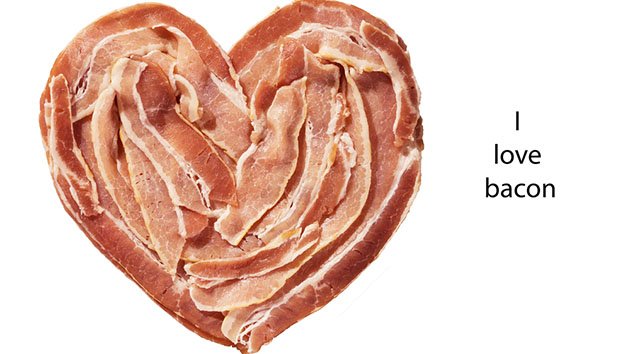
<a href="http://www.shutterstock.com/cat.mhtml?lang=en&language=en&ref_site=photo&search_source=search_form&version=llv1&anyorall=all&safesearch=1&use_local_boost=1&search_tracking_id=DvNcRPEh0M7WN1jYJ06o1w&searchterm=bacon%20heart&show_color_wheel=1&orient=&commercial_ok=&media_type=images&search_cat=&searchtermx=&photographer_name=&people_gender=&people_age=&people_ethnicity=&people_number=&color=&page=1&inline=173276933" target="_blank">Tom Grundy</a>/Shutterstock
As we all know, the internet is obsessed with bacon. Physicians, however, are usually less bullish about the delicious yet notoriously artery-clogging treat. Until now: Over at the medical blog KevinMD, Dr. Jennifer Gunter combs the scientific literature and turns up three actual medical conditions that bacon can help treat:
- Nosebleeds. Last October, Stanford otolaryngologist Ian Humphreys developed a nasal tampon made out of bacon that cured a young girl’s bloody nose, an accomplishment for which he was awarded a 2014 IgNobel Prize in medicine. “Apparently the high salt content of bacon is believed to induce swelling which causes the blood vessels to constrict slowing the flow of blood and helping clotting,” writes Gunter. When Humphreys won the IgNobel, Robert Jackler, chair of Stanford’s otolaryngology department, told Stanford’s Scope medical blog, “We are squealing with pride.”
- An incredibly disgusting-sounding infection called furuncular myiasis in which the larvae of an insect called Dermatobia hominis nest in the human soft tissue or skin, resulting in boils and sometimes tissue destruction. Shudder. “The treatment largely consists of manually picking out the larvae with tweezers,” writes Gunter. “Apparently bacon fat can be used as bait to lure the larvae to the skin surface for faster and more effective removal.”
- Scabies. Apparently, bacon fat was once used in topical sulfur and salicylic acid creams used to treat this itchy and highly contagious skin infection. A 1991 study compared the bacon fat formulation to the more modern cold cream version and finds, Gunter writes, that “while the cold cream combination was 100% effective versus 88 percent for the bacon fat base the authors noted that the bacon fat concoction was 238 times less expensive than the cheapest scabicidal medication in the U.S.”
So there you have it: bacon as medicine. Something to keep in mind if you have any left over after you make that gross bacon lattice thing for your Super Bowl party.
















